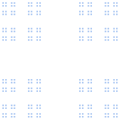Cantor set
The Cantor set is a subset of real numbers with certain properties that are interesting to mathematicians. These properties relate to topology, measurement, geometry, as well as set theory. Some of them are:
- When represented geometrically,[clarification needed] the set is a fractal, it has a Hausdorff dimension which is not an integer
- It has the same cardinality as the set of real numbers
- It is self-similar
The set is named after Georg Cantor. Henry John Stephen Smith discovered it in 1875, and Cantor first described it in 1883.
The set is made by starting with a line segment and repeatedly removing the middle third. The Cantor set is the (infinite) set of points left over. The Cantor set is "more infinite" than the set of natural numbers (1, 2, 3, 4, etc.).[1][2][3] This property is called uncountability. It is related to the Smith–Volterra–Cantor set and the Menger Sponge. The Cantor set is self-similar.
Cantor Set Media
Cantor cubes recursion progression towards Cantor dust
Related pages
Other websites
- Barile, Margherita and Weisstein, Eric W. "Cantor Set". Wolfram MathWorld. Retrieved 23 January 2012.
{{cite web}}: CS1 maint: multiple names: authors list (link) - Su, Francis E.; et al. "Cantor Set". Math Fun Facts. Archived from the original on 14 January 2012. Retrieved 23 January 2012.
- Neal Carothers. "The Cantor Set". Archived from the original on 2012-02-04. Retrieved 2012-01-23.
- Cantor set at PRIME Archived 2012-02-23 at the Wayback Machine
 Media related to Cantor sets at Wikimedia Commons
Media related to Cantor sets at Wikimedia Commons
References
- ↑ "Theory of Infinite Sets". Exploratorium.edu. Retrieved 2012-01-27.
- ↑ Erin Chamberlain. "The Cantor Set" (PDF). Retrieved 2012-01-27.
- ↑ Rupert Levene (February 13, 2009). "The Cantor set is uncountable" (PDF). Retrieved 2012-01-27.








